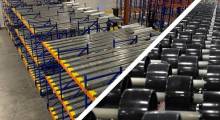Yale Materials Handling Corp. (Booth S1003) has announced the latest addition to its robotic lift truck lineup. The Yale MC10-15 Driven by Balyo, a counterbalanced stacker model capable of both point-to-point horizontal transportation and vertical movement, is able to autonomously retrieve or deposit pallets from elevated spaces.
According to Mick McCormick, vice president of warehouse solutions, the vertical capability offers the versatility to perform tasks like the transfer of pallets from floor-level staging areas to conveyor lines, loading and unloading in crossdocking applications, and stacking on elevated storage racks. The lift truck can switch from automatic to manual mode at the touch of a button or move of the tiller, providing additional capacity to handle unplanned challenges or fluctuating demand.
“People in warehouses think of automation as conveyors and mechanization, but this is something else,” McCormick said. “This is based on a conventional lift truck that can be operated automatically and offers an easy path to more automation. It can be deployed with no WMS integration, or it can be completely integrated. As customers work their way up from manual to automated, they can scale and adapt along the way.”
McCormick said the largest opportunities for the robotic lift truck are in environments where the operator is continuously directed and required to make fewer decisions. Still, the lift truck can provide a strong ROI even in unstructured environments by helping address seasonal peaks, labor shortages and “churn,” which includes the time and expense of training a new operator.
“When you add the savings from labor, efficiency, reliability and responsiveness in a two- or three-shift environment, the return comes very quickly,” he said.
The counterbalanced stacker model uses the same infrastructure-free navigation technology as the Yale MO70T tow tractor and MPE080-VG end rider Driven by Balyo models.
Article topics








